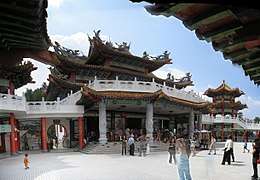Dhammikarama Burmese Temple
| Dhammikarama Burmese Temple | |
|---|---|
| ဓမ္မိကာရာမမြန်မာကျောင်း (Burmese) | |
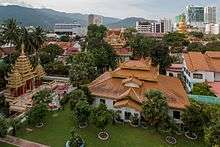 | |
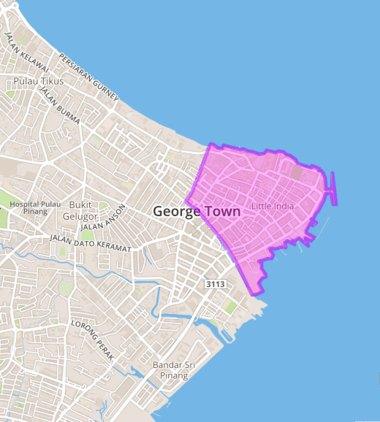 Location within George Town | |
| Geography | |
| Coordinates | 5°25′51.9558″N 100°18′50.2812″E / 5.431098833°N 100.313967000°ECoordinates: 5°25′51.9558″N 100°18′50.2812″E / 5.431098833°N 100.313967000°E |
| Country | Malaysia |
| State | Penang |
| Locale | Pulau Tikus |
| Location | George Town |
| Culture | |
| Sanctum | Buddha |
| Major festivals | |
| Architecture | |
| Architecture | Burmese |
| History | |
| Date built | 1803 |
Dhammikarama Burmese Temple, located at the Pulau Tikus suburb in George Town, is the sole Burmese Buddhist temple in the State of Penang, Malaysia. Built in 1803, it is also the oldest Buddhist temple on Penang Island.[1][2] The temple is situated directly across Burmah Lane from Wat Chaiyamangkalaram, a Thai temple.
Established as a kyaung (monastery), Dhammikarama Buddhist Temple serves as a retreat for Buddhist devotee, with a monks' quarters, a preceptees' lodge and a library within the temple grounds.[2][3] Numerous statues of the Buddha and mythical creatures are scattered within the temple, including a pair of winged chimeras known as 'Panca Rupa' and a huge mural depicting the Renunciation of the Buddha.[1][3]
At the time of writing, the Chief Abbot of Dhammikarama Burmese Temple is U Paññāvamsa, who is also the Chief Abbot of the Burmese Buddhist Temple in Singapore.
History
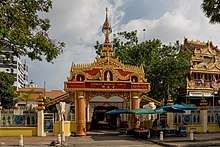
Dhammikarama Burmese Temple was established in 1803 as the Nandy Moloh Burmese Temple.[1][3] The site where the temple now stands had been purchased by one of the temple's female patrons, Nonya Betong, from George Layton for $390 (Spanish dollar); the land was subsequently granted by the then Lieutenant-Governor of the Prince of Wales Island, Sir George Leith. The first Chief Abbot of the temple was U. Nandamala.[3]
The oldest portion of the temple is its stupa, which was consecrated in 1805.[1][4] This stupa was then enshrined within an outer stupa that was built in 1838, along with the temple's Sima Hall, which is guarded by a pair of stone elephants.[1] The Sima Hall was last renovated in 1995 to cope with the increase in the number of devotees.[2] In addition, a well was also dug for use by the surrounding Burmese community; with the advent of piped water, the well has since been disused.
The Arahant Uppagupta Shrine was originally constructed as a wooden structure in 1840.[3] It was replaced by the current shrine in 1978, and is said to possess the power to ward evil spirits, obstacles and dangers.
The temple's other structures were of more recent construction.
Description
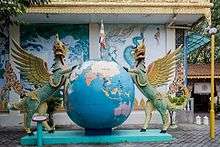
Several statues of the Buddha and mythical creatures can be found inside the temple. For instance, a pair of winged chimeras called 'Panca Rupa', or the 'Guardian Protectors of the World', combines the features of various creatures such as elephants, fishes and the garuda to symbolise the three realms of land, air and sea.[1] As with other Burmese temples, the chinthe is another prominent creature within Dhammikarama Burmese Temple.
The Renunciation of the Buddha mural depicts the Buddha, encouraged by the Devas, renouncing his earthly desires for the life of an ascetic, while demons attempted to dissuade him.
The newest addition to Dhammikarama Burmese Temple is the Golden Pagoda Bell Tower, which was completed in 2011.[5] As with the rest of the temple, the pagoda is steeped in Burmese architectural styles, with artisans brought in from Myanmar specifically for the construction of this structure.
See also
References
| Wikimedia Commons has media related to Dhammikarama Burmese Buddhist Temple. |
- 1 2 3 4 5 6 Khoo, Salma Nasution (2007). Streets of George Town, Penang. Penang: Areca Books. ISBN 9789839886009.
- 1 2 3 Howard Tan, Keith Hockton (2012). Penang: An Inside Guide to Its Historic Homes, Buildings, Monuments and Parks. Petaling Jaya: MPH Group. ISBN 9789674153038.
- 1 2 3 4 5 III, Administrator. "Dhammikarama Burmese Buddhist Temple". www.visitpenang.gov.my. Retrieved 2017-05-10.
- ↑ Chuah, Jin Seng (2013). Penang 500 Early Postcards. Editions Didier Millet. ISBN 9789671061718.
- ↑ "Monk's vision realised - Community | The Star Online". www.thestar.com.my. Retrieved 2017-05-16.



%2C_Sentul%2C_Kuala_Lumpur.jpg)
